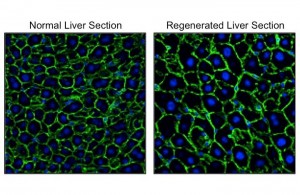Surprising properties of hepatocytes Hepatocyte hypertrophy and unconventional cell division underlie liver regeneration


Visualization of nuclei (blue) and outlines (green) of hepatocytes. Hepatocytes in the regenerated liver (right) were significantly larger than those in the normal liver (left). © Yuichiro Miyaoka
The liver has a remarkable ability to regenerate. Even when 70% of a mouse’s liver is removed, the remaining tissue recovers lost mass and function. It has been accepted that liver regenerates by hepatocyte cell division, but to date there has been no direct evidence for this hypothesis.
Drs. Yuichiro Miyaoka and Atsushi Miyajima and their research group at the Laboratory of Cell Growth and Differentiation, Institute of Molecular and Cellular Biosciences, the University of Tokyo, have revealed that during liver regeneration hypertrophy is more important than cell division and hepatocytes undergo unconventional cell division, requiring a significant revision of the currently accepted model of hepatic regeneration.
This research result provides a better understanding of the mechanisms underlying liver regeneration, and may lead to improvements in liver transplantation from living donors.
Press release (Japanese)
Paper
Yuichiro Miyaoka, Kazuki Ebato, Hidenori Kato, Satoko Arakawa, Shigeomi Shimizu, Atsushi Miyajima,
“Hypertrophy and Unconventional Cell Division of Hepatocytes Underlie Liver Regeneratio”n,
Current Biology Online Edition: 2012/6/1 (Japan time), doi: 10.1016/j.cub.2012.05.016.
Article link
Links
Institute of Molecular and Cellular Biosciences
Laboratory of Cell Growth and Differentiation (Japanese)
The Japanese Society for the Research of Hepatic Cells (Japanese)






